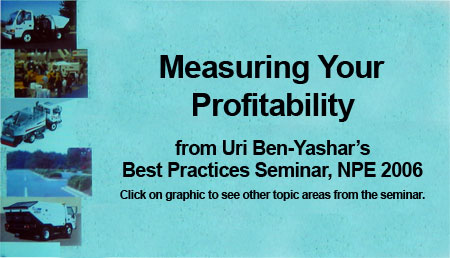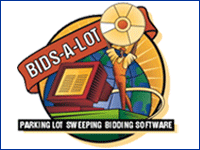Best Practices |
Measuring, Assessing and Increasing Your Sweeping Company's Profitability
This information was provided by one of the focus groups at the seminar organized by Uri Ben-Yashar at NPE 2006. This focus group provided an overview on GPS systems as they apply to parking area sweeping.Topic area moderator was Dale McCaskill, principal in South Carolina-based South Company Sweeping & Maintenance. Gale Holsman, principal in American Sweeping, Inc. (and the WorldSweeper.com Award of Excellence in Sweeping winner for 2006) was the presenter for the topic.by Ranger Kidwell-Ross
Never confuse the term 'revenue' with the word 'success.' It is profit that matters. Being big isn't the key. What really means something is profit. Set your goals such that you can project and measure the business you need to do in order to get there. Clearly, if you want to make $100,000 in personal income, you can't do it by grossing $80,000. You must set goals -- and then develop and action plan -- designed to get you to the level of gross billing such that the profit involved will allow you to attain your target income level. Holsman pointed out that, in the many years of going to tradeshows, what he hears everyone asking each other is "How many sweepers do you own?" Those with many sweepers are thus accorded more status. In his opinion, what people should be concerned with is, rather, "How much money did you make last year?" You'd find that some of the people with fewer sweepers and other rolling stock are actually in a higher income bracket than those who have been concentrating on growth for growth's sake. 
For example, one of the best ways to grow your business quickly is to price under market level, with a low to non-existent profit built in. Accounts will be easy to sign up, and you will soon need more sweepers in order to service all your accounts. The problem is, you'll soon have a large business that isn't profitable, or that is less profitable than it should be given the size of your client base. You must look at your hourly rates. Some contractors bid parking lot sweeping by the square foot. In this seminar, none of the more successful contractors did so. Rather, all bid by the amount of time it took to do the job. Then, even further, none of them considered their billing by the hour; all said they 'drilled down' to the minute. Without considering costs by the minute, there was agreement, then money that should be billed is left on the table. Then, it's vitally important to consider each and every detail of your costs of doing business in order to make a determination of what it costs to run your sweepers. Most contractors simply do not roll in all the costs associated with running their business when they cost out their price per hour for their sweeping services.
It is vitally important that you figure out absolutely every cost associated with running your business and make sure to include them -- as well as add in your profit margin -- on each and every one of them. Then, next is to figure out where your profit is coming from. When you analyze your profit picture, which services are they that are bringing you the larger portions of your income? Is it from your 'Wal-Mart accounts,' or from your construction sweeping, or the gated community sweeping, etc.? You look at this per month and per week. At the same time, you have to keep in mind your accounts receivable position. There may be some accounts that appear profitable, but when you factor in their late paying and any time it takes calling them to get paid, they may actually be unprofitable overall. You need to know exactly how your company is flowing. Consider that you may have a considerable amount of money in the bank and actually be unprofitable. That circumstance can occur when you don't consider your long-run costs, such as amortizing the costs of eventual sweeper replacement.
The key to controlling profitability: Few business owners realize that their lack of control over the bottom line is largely from a flawed method of measuring profitability. Until you realize you must measure velocity of sales effort, as well as marginal profit, you cannot gain effective control over your bottom line. Here are some methods to improve profitability: Develop and monitor profit centers. This is especially important when you do multiple services. If all you do is sweeping, then divide your types of sweeping out as individual profit centers. Improve your bidding and estimating process. Don't chase the unprofitable accounts. When one of the national accounts calls and wants you to sweep a group of chain stores for a ridiculous price per sweep, just say no. Instead, concentrate on the 'ma and pa' businesses, the small strip centers and the other places where you can make a decent profit. Call on new prospects that have a higher profit potential. Many contractors go down the main drag and stop at all the more major stores and centers in order to drum up new business. The savvy contractors go at least a street or two off the main thoroughfares to talk to those businesses. Think of it as the 'blue highways' approach. You'll find those secondary-type businesses have just as much need for sweeping, yet because the competition is not as great the pricing for handling them can be more realistic. Take a look at your current accounts and determine which are bringing in the most profit. These are the accounts you need to concentrate on in terms of both supporting in your current services and in selling additional services you offer. When you find accounts in your customer list that are not bringing in the profit you require, then modify their pricing. Though you may lose some, in the long run your profit picture will improve. While you're at it, figure out how it is you priced your service with them too low to begin with. Develop and implement productive improvement plans. Take a look at each and every area of your costs, from purchase of parts and wear items to how your employees do their work. Are you doing things in any area simply because that's the way you've always done them? Itemize and list these, then scrutinize each to see if there is a way you can reduce the cost. [Editor's Note: Remember that when you make an additional $100, what goes to your bottom line is the profit on that money, e.g., $5 to $10 of the $100. As a contrast, when you reduce your costs by the same $100, that entire amount goes to your bottom line.] Know what your costs are in every part of your business. How much does one sweeper cost per hour to operate, including absolutely everything, from wear items to eventual replacement? What is your marketing cost to attain a new client, including absolutely everything, from advertising to meeting with them to sign them up for service? "Fire the bums." What is your retention cost for each of your clients, i.e., when you have to spend time 'babysitting' a particular customer or doing re-sweeps because they're never satisfied, then there are added costs associated with that fact. Some customers are simply more trouble than they're worth. If that's the case, 'fire' them. Don't keep them just to keep them out of your competitors' hands. It's better that they have them, isn't it?! Consider diversifying in order to increase your overall profit. One of the big advantages to sweeping is the relationships you're able to build because you're on the properties all the time. Figure out what other services you can provide to your current customers in order to increase your level of profitability. At the same time, consider other types of sweeping you might add, such as roadway sweeping, construction sweeping, airport sweeping, etc. Learn how to do income averaging as a business assessment technique. There's no way to know what your business trend is when you look at the volume of business/profit amount for a given month. One of the best ways to determine that is, each and every month, to average your income and profit over the previous 12 month period. You should have an upward trend. This technique takes out the seasonality factors from your P & L. Remember that you don't have to grow your company simply by doing more of what you're doing now. Look around at the needs of your current customers, then find ways to fulfill those needs in a profitable manner. You'll save on your customer acquisition costs, be providing a higher overall level of customer support to current accounts such that they should be even more loyal to you, and you'll have added diversification to your company. If you have any questions about any of the above ideas, feel free to contact the WorldSweeper.com Team for a further explanation. |
© 2005 - 2012
|
Parking Area Sweeping Contents
|